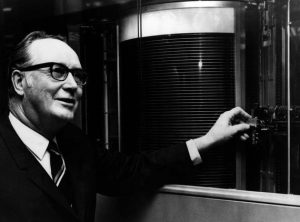History (1998): Rey Johnson, Father of HDD, Dies at 92
At IBM for 35 years
This is a Press Release edited by StorageNewsletter.com on March 17, 2022 at 2:00 pmA prolific inventor, Reynold Benjamin Johnson was not that well known in the industry, preferring to keep a low profile. He can, however, be considered the true father of the computer HDD.
Rey Johnson in front of IBM RAMAC

Born July 16, 1906, in Dassel, MN, of Swedish immigrant parents, he died on September 13, after a battle with cancer. He is survived by his wife Beatrice, and had 3 children.
IBM’s internal literature has plenty to say about him. He was a University of Minnesota alumnus with a degree in education. Around 1932, while teaching high school science in Michigan, he developed an electronic device for scoring multiple-choice tests by effectively counting answer-sheet pencil marks. Two years later, IBM informed him of its interest in his device. He was promptly hired as an engineer and assigned to the Endicott laboratory, which developed the IBM 305 Test Scoring Machine, announced in 1937. Johnson then helped develop a mark-sensing reproducer that could read pencil marks on decimally formatted cards and appropriately punch the cards.
During World War II, he directed a variety of IBM developments for the armed forces. Following the war, he became interested in wire-matrix printing. In 1949, W Wallace McDowell, the Endicott laboratory manager, proposed the establishment of a separate group for advanced developments.
Named laboratory manager on January 15, 1952, Johnson soon signed a 5-year lease on a stuccoed cement-block building at 99 Notre Dame Avenue, San Jose, CA, with locally hired talent totaling no more than 50.
In May 1955, disk technology advances were announced, and in September 1956, the 305 Ramac, the first HDD, was officially launched, with 4.4MB capacity on 50×24-inch platters, at a $11,000 price per megabyte.
Johnson was later involved in a half-inch videocassette project used by Sony, and ultimately for the VCR.
He stayed with IBM for 35 years, and his name is on more than 90 patents. He was named an IBM fellow.
After retiring in 1971, he continued with his inventions, including Fisher Price’s microphonograph and a device that enables the writing of Chinese characters with only one stroke.
This article is an abstract of news published on issue 129 on October 1998 from the former paper version of Computer Data Storage Newsletter.














 Subscribe to our free daily newsletter
Subscribe to our free daily newsletter

